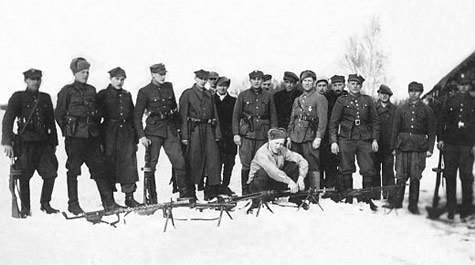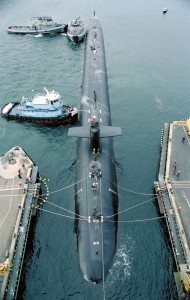Monthly Archives: October 2012
Once again, there are too many people acting rashly, incompetently, or just plain criminally with weapons for everybody to get his own post. So we’ll jumble them together, beginning, say, with the idjits and advancing through the skells and whackos to the hardened prestoopnicks.
Something just smells wrong about this one
 A guy in Pennsylvania saw the biggest skunk ever in his back yard, and let the polecat have it with a 12-gauge. Only then did he figure out that it was a 9-year-old girl in a black and white costume, one of his own relatives attending a Halloween party. Her injuries didn’t initially appear life-threating, but she was life-flighted to hospital, and the would-be Skunkslayer is assisting police with their enquiries — although he has yet to be charged, or even named.
A guy in Pennsylvania saw the biggest skunk ever in his back yard, and let the polecat have it with a 12-gauge. Only then did he figure out that it was a 9-year-old girl in a black and white costume, one of his own relatives attending a Halloween party. Her injuries didn’t initially appear life-threating, but she was life-flighted to hospital, and the would-be Skunkslayer is assisting police with their enquiries — although he has yet to be charged, or even named.
Hot tip: ignored skunks walk off. Shot skunks often release their scent glands’ contents in the muscle relaxation that comes with death. So shooting a skunk is a really bad idea, even if it’s not a four foot tall skunk. Which should be a clue.
Amazingly, police say alcohol was not a factor. Some guys don’t need to dip into the judgment juice to wind up in this space.
When swords are outlawed…
 The subway riders of Phoenix, Arizona will lose their secret defender. Two guys were beating the living daylights out of a third when an unknown citizen took the law into his own hands… producing a 30-odd-inch Japanese-style sword, katana or possibly a wakizashi. The assaulters departed hastily, while the assault victim stood in the railcar door, hurling abuse at their receding forms. (Video at the link). The swordsman sheathed his implement and rode off into the sunset. No word if 46 other ronin followed him.
The subway riders of Phoenix, Arizona will lose their secret defender. Two guys were beating the living daylights out of a third when an unknown citizen took the law into his own hands… producing a 30-odd-inch Japanese-style sword, katana or possibly a wakizashi. The assaulters departed hastily, while the assault victim stood in the railcar door, hurling abuse at their receding forms. (Video at the link). The swordsman sheathed his implement and rode off into the sunset. No word if 46 other ronin followed him.
Well, they often say that many defensive weapons uses resolve the situation with mere display of the weapon. Stands to reason a three-foot-long piece of gleaming, sharp steel might work for that.
It always works for Jackie Chan
 But a Winslow, Maine woman found that the decorative nunchaku in her apartment didn’t stop an aggressive, armed ex-boyfriend. She did put a hurtin’ on him, and wriggled away, as he at various times used two different knives, a pull up bar, and his own superior speed and strength. She managed to get a 911 call out and the ex, one Christopher Rolling Fox, is now Christopher behind Bars and Locks. You really should read the whole article to see how the whole fight went (not to mention a mugshot of an amusingly bruised Rolling Fox). If he had stopped for a moment to think… well, he just doesn’t seem to be that kind of guy.
But a Winslow, Maine woman found that the decorative nunchaku in her apartment didn’t stop an aggressive, armed ex-boyfriend. She did put a hurtin’ on him, and wriggled away, as he at various times used two different knives, a pull up bar, and his own superior speed and strength. She managed to get a 911 call out and the ex, one Christopher Rolling Fox, is now Christopher behind Bars and Locks. You really should read the whole article to see how the whole fight went (not to mention a mugshot of an amusingly bruised Rolling Fox). If he had stopped for a moment to think… well, he just doesn’t seem to be that kind of guy.
Our advice to the lady is, get some training and a gun. To Mr Fox, we’d like to send the message that most of the trouble guys get into is caused by the delusion that one woman is materially different from another. When you get out again, take that one to heart.
Some are Desperate to Escape Anonymity
A skinny comedian nobody ever heard of is accused of pulling a gun on a morbidly obese actor than nobody ever heard of, in an incident that nobody ever heard of unless they unwisely follow a link to a gossip column like we did. Complete with video of skinny guy’s post hoc gangsta-wannabeeism. Yawnsome.
Who cares? These guys could probably whack each other and make the net level of talent in the world go up.
Cops Shoot another Naked, Irrational Person
 This time, in Florida, Saturday. The cops are saying the woman had “a weapon,” but they won’t identify the weapon, which is pretty much all you need to know — if it was a lethal weapon, and they were seriously threatened, and not just trigger-happy, the weapon would have been on the six o’clock news. Almost certainly drugs were involved, as with the University of South Alabama shooting. Two cops, Rocky Howard of the Hernando County Sheriff’s Office and William Mechler of the Tampa PD, have been given extra vacation time as a reward for the shooting. They were off-duty at the time, attending the same wild party as the naked woman. Apparently, unlike the deceased woman or an armed civilian in a shooting, they were not tested for drugs or alcohol, thanks to police union protections.
This time, in Florida, Saturday. The cops are saying the woman had “a weapon,” but they won’t identify the weapon, which is pretty much all you need to know — if it was a lethal weapon, and they were seriously threatened, and not just trigger-happy, the weapon would have been on the six o’clock news. Almost certainly drugs were involved, as with the University of South Alabama shooting. Two cops, Rocky Howard of the Hernando County Sheriff’s Office and William Mechler of the Tampa PD, have been given extra vacation time as a reward for the shooting. They were off-duty at the time, attending the same wild party as the naked woman. Apparently, unlike the deceased woman or an armed civilian in a shooting, they were not tested for drugs or alcohol, thanks to police union protections.
Moral of story: don’t take drugs, and don’t go naked around cops — they can’t handle it.
Update: Her name was Inga Swanson, and she was carrying a cross and/or a decorative, non-firing antique gun. She was worried about the “End Times”… for her, they were indeed. She has apparently been delusional for some time -excuse us, had been. Not really funny, this.
One wishes that there were some way to deal with the mentally ill short of shooting them dead and ending all their mortal travails.
Sometimes the good guys win one. even if they’re girls. even if they’re only 12.
 That’s how old Kendra St. Clair is, and she hid in a closet after calling her mom to tell her a big, scary dude was breaking into their rural Oklahoma home. Mom told her to closet up, and gun up, and Kendra dutifully did. Mom called 911.
That’s how old Kendra St. Clair is, and she hid in a closet after calling her mom to tell her a big, scary dude was breaking into their rural Oklahoma home. Mom told her to closet up, and gun up, and Kendra dutifully did. Mom called 911.
The police still hadn’t arrived when the burglar, one Stacey Jones, arrived at Kendra’s closet and got the surprise of his life — nearly the last surprise of his life. Yep, she shot him, right in the boiler room. He ran, wounded … and the arriving police ran him down and transported him for, first, medical help for the .40 slug in his chest, and then to a “recovery room” with barred windows in a county facility. He’ll have some time to consider the benefits of a career change, unless somebody feels like standing his quarter-million in bail. Reportedly, he was homeless and scavenging for food, but he looks pretty well-fed in the photos at the link, and what food was he looking for in a bedroom closet?
“I kept my head on straight,” Kendra said. She deserves to be proud, because she surely did.
The mighty power of the Restraining Order
A whiny attorney (but we repeat ourselves) in Wisconsin notes that a shooter who killed several people at his soon-to-be-ex-wife’s workplace and then himself was under a restraining order at the time.
Once again, we’re impressed at how this kind of legal paper really restrain people. Gee, the lawyers are really brilliant about that stuff, aren’t they?
Sure are. This guy’s answer: to restrict the rights of all the people who didn’t commit the crime.
That’ll definitely work.
Guns don’t kill people, golf clubs kill people.
At least they do in the hands of the Kennedy family, who’ve also killed people drunken driving, playing stupid games skiing, and shooting up heroin, all well-established Kennedy pastimes, and who have been saved from a higher body count by medical advances. Cousin Michael Skakel used his family’s clout to evade justice for a decade and a half after he smashed 14-year-old Martha Moxley’s head in with a golf club, for not putting out. (Droit du seigneur is another Kennedy family tradition, practiced with babysitters, waitresses, and any other available, low-clout female).
You’ll be delighted to learn that Skakel is up for parole just ten years after justice belatedly put him where he belongs, and the Kennedy family are pulling for him: after all, he hasn’t done anything the rest of them haven’t at least tried, and “he’s been a model inmate.” (Personally, we think the latter is a great argument for leaving him where he is. It’s hard to get good inmates these days!). Reportedly, he’s in a minimum security facility… where he can practice his swing.
Martha’s brother John wrote an angry letter to the parole board, pointing out that Skakel has shown not the least indicator of remorse. “Michael Skakel is representative of the most dangerous aspect of our society. in that he was raised in an environment in which he was exposed to, and at some point embraced. the mindset that the rules of our general society did not then and do not now apply to him…. And, I believe that Michael Skakel’s inbred sense of self and his self-confessed quick temper will always represent a threat to society.”
Right now, the nation is suffering a terrible interregnum without a Kennedy in Congress, but Camelot fans take heart — Massachusetts is about to elect another. Not Michael Skakel, though, who has to get out of crowbar motel before he advances his career. He probably will, though…”the rules of our general society did not then and do not now apply to him.”
And that’s probably a good place to stop… a reminder that it’s not the object, but the intent of the man whose hand is on it. Millions of people use golf clubs to play a harmless (if frustrating) game. It takes a narcissistic sociopath, or a Kennedy (but we repeat ourselves) to make a murder weapon out of one.
U-534’s Last (intact) Resting Place
This incredible photo was found by a retired SF medic in this Flickr photostream, and needed to be shared with you all. We’ve never seen a photo that captures so well, and simultaneously, the sinister aspect of this naval weapon, and the bleak tone of a naval defeat.
The submariners of the World War were elite warriors — a technological elite,defined by their special weapon and its unique demands and risks. Most of the German U-boat sailors gave up their souls to the sea, as did most of their Japanese counterparts and a sunstantial minority of Allied undersea warriors. (Underwater as on land, it pays to win).
The American submariners say that their mates and their vessels are “on Eternal Patrol.” There’s poetry in that.
The crew of U-534, most of them, anyway, are not among them. They survived the loss of their boat. The boat was salvaged from its watery grave off Denmark 20 years ago, and for a while was displayed as you see here, near Liverpool — ironically, a port which figured in the same Battle of the Atlantic. There were various plans whirling around the boat, but we think none of them came to fruition. Some time in 2008 she was cut into four pieces, to prepare her for a new life as a tourist attraction (letting people see into the cramped interior of the boat), but as far as we know the attraction was never completed.
The American subs were instrumental in winning the war in the Pacific, and the German ones were their nation’s best shot at winning the war in Europe.
U534 was the last U-boat sunk in the War, after the order for surrender had been given. Sunk off Anholt and her crew rescued to Aarhus. Found in 1986, recovered in 1993 and transported to Birkenhead, Wirral in England about 2 years later.
During her service, U-534 conducted three patrols under one single commander, and sunk zero ships. She was attacked by Britich aircraft twice, and shot down two attacking aircraft, a Wellington in 1944 and a Liberator in May, 1945 (note the dual guns on her conning tower). Another Liberator sink her. One man from the shot-down Liberator survived. Uboat.net has the story of her sinking:
U-534 was first attacked by Liberator E for Edward from 547 Sqdn, which was shot down with the loss of 5 of the crew of six. Then G for George of 86 Sqdn began a second attack. On the first run none of the depth charges detonated, but one lodged on the casing just aft of the conning tower. Explosions from near misses in the second run dislodged it, and it exploded beneath the hull.
All the crew escaped, but one died through exhaling while ascending to the surface from the sunken boat, and 2 from exposure in the water, one of whom, the radio operator, was Argentinean. They were picked up by lifeboats from the Anholt lightship approximately one mile away, as were the crew of E Edward.
The captain of G for George, Warrant Officer John Nicol, was awarded the DFC. The bombardier was Flying Officer Neville Baker.
Remarkable times, remarkable men… and quite a remarkable photo. Be sure to click to embiggen this one.
Wednesday Weapons Website of the Week: Doomed Soldiers
Admin note: this should have run yesterday. But… we had enough posts, and analog things to do.
OK, the weapons content is indirect but the unconventional warfare content is extremely rich. Special operations forces, especially those tasked with UW, CT, Hostage Rescue, or Personnel Recovery missions (all of which except HR have been on our mission tasking letter at one time or another) study insurgencies — successful and unsuccessful — and prisoner/personnel recoveries, especially successful and nearly successful ones from hard targets, obsessively and assiduously.
Imagine our shock to discover that there was a UW force that conducted dozens of such raids, and that operated in the oppressive rear area of a totalitarian Soviet slave state for 19 years. Surviving photos — many of which are reproduced at the linked site — ahow guerillas dressed proudly in uniforms as Polish as they could make them, armed with weapons of Russian and German provenance, presumably by battlefield recovery. The Soviets and their Polish quislings always claimed that the guerillas were being armed by the US and UK, but if they were, they were not being armed with Western weapons but with German and Russian ones.

Polish guerrilla band, January 1946. By now, they’d been fighting behind Russian lines for almost two years. Note German LMGs. Unfortunately no larger size at hand (this is full size). Most if not all of these men would die in combat or be executed.
The leaders of this resistance, like the leaders of the effective resistance in France and Norway, for example, were often Army officers who had escaped Russian massacres of prisoners or defected from Polish communist formations. Given the trouble they gave the Russians later, maybe the Russians were remarkably prescient when they massacred some 30,000 Polish officer prisoners at Katyn.
We were struggling with the Polish language of a website memorializing the Polish Underground, thinking, “Polish or not, this has to be a future W4” when we discovered, mirabile dictu, that there is an English language version containing much of the content from the Polish site. (Also, for those of us who can struggle through the Polish having mastered loosely related Slavic tongues, providing a quick cross-check on many definitions and terms. Woo hoo!).
The Polish Underground was sometimes fragmented (which provided an unintended compartmentation that helped its long survival in brutally difficult conditions). It was vilified by fifty years of fabrication in the Polish slave media. It was pursued in turn by the Gestapo, the NKVD, and various Polish quisling groups that made a generally seamless transition from licking German boots to Russian ones. The Communist forces, in particular, had a utilitarian morality that let them operate with no discernible limits or connexion to civiization.
The Poles also were, as ever, victims of both their nation’s indefensible geography, and its relative unimportance to the powers of the day. Polish history is a long litany of being overrun, abused, and yet even both of the nightmare tyrannies of the 20th Century were unable to quench the flame of Polish freedom — even when they worked in concert, as they did in 1939-41.
While the brave Poles were, indeed, Doomed, the produced enough history and heroes to overwhelm even a larger nation, and now a small cadre of historians is determined — as determined as their doomed rebel fathers — to winkle the truth of the resistance out from under the layers of lies deposited over five decades of slavery by Nazis, Communists, and the abominable Polish quislings who sold their souls to them.
Here is a brief blurb for an article on prisoner rescues:
An Assault on Włodawa, October 22, 1946 – During 1944 -1947, there were 88 major assaults on Communist detention centers and prisons. During more than 100 such operations, the prisoners were not only freed from Communist militia stations, jails, transport convoys and hospitals, but more often-than-not, were saved from certain death. While carrying out these operations, and risking their own lives, the partisans brought freedom to their brothers-in-arms, and their countrymen in general; all in all, around 5,000 individuals were freed. NEW!

The Order of Rebirth of Poland — retroactively & posthumously rewarded to the greatest of the resistance fighters, like Leon Taraskiewiecz, seated in the photo at top of this post.
Most of the liberated, and the liberators, would still end like most of the underground army did — against a wall, and then in a nameless grave or secret cremation that Polish quislings eagerly adapted from the Nacht und Nebel policy of one of their interchangeable foreign masters. But the spirit of freedom never died, and the Russian yoke never hung comfortably on Polish shoulders.
Poland is now under threat again. Once again the Russians scowl at Polish independence, and once again Western powers seek to deal Polish independence away to appease an expansionist, totalitarian power. (The first major foreign policy decision of the current US administration was to pull the rug out from under Polish and Czech participation in ballistic missile defense of the West, in a futile attempt to appease Vladimir Putin). History teaches that such ambitions will find opponents — perhaps not in Paris, Berlin, London and Washington, but certainly in the farm villages and urban streets of Poland.
Max Boot on our shrinking Navy
 Max Boot should require no introduction. In the world of defense intellectuals, he swings a much bigger cat than your humble blog authors. (True, he probably hasn’t ever leaped into a live-fire shoot house as a sniper split a concrete block with a terrorist target on it six inches above his head, and he probably hasn’t sat with a foreigner and convinced him to betray his country, tribe and family for the USA; but at what he does do, analyzing defense issues, he’s a name for a reason). Writing in Commentary magazine’s blog, and riffing off a line from the Presidential debate, Boot explains why we need not only the best ships and crews (which we have) but enough ships and crews.
Max Boot should require no introduction. In the world of defense intellectuals, he swings a much bigger cat than your humble blog authors. (True, he probably hasn’t ever leaped into a live-fire shoot house as a sniper split a concrete block with a terrorist target on it six inches above his head, and he probably hasn’t sat with a foreigner and convinced him to betray his country, tribe and family for the USA; but at what he does do, analyzing defense issues, he’s a name for a reason). Writing in Commentary magazine’s blog, and riffing off a line from the Presidential debate, Boot explains why we need not only the best ships and crews (which we have) but enough ships and crews.
Like a lot of clever debate lines, however, it grows less and less persuasive the more it is examined. Jonathan has already raised some sound objections. My own view is that while Obama is technically right–no question naval vessels today are a lot more potent than they were in 1916–he is wrong in the larger sense, if he is suggesting that quality can endlessly substitute for quantity.
Yes, one Navy ship today can fire more munitions farther and more accurately than a whole fleet could have done at the Battle of Jutland. But the odds of such an encounter between great fleets at sea are exceedingly small. No other nation has a blue-water navy today. But that doesn’t mean that the threats faced by our navy have diminished.
Today the U.S. Navy must …. The operational tempo dictated by these requirements is terrific, as I have seen for myself in the last few years in visits to the 5th Fleet in the Persian Gulf and the 7th Fleet in Japan.
The ships we have are, when not retrofitting in port, almost constantly at sea and they are struggling to keep up with threats …. Yes, the capabilities of each naval ship are greater today–but so are its range of potential missions and so are the capabilities of our potential foes. China is expanding its maritime capabilities at a rapid clip; the U.S. Navy is struggling to keep up and the balance of power in the Western Pacific is shifting against us.
via On National Defense, Quantity Matters Too « Commentary Magazine.
For Army guys, here at WeaponsMan, we talk a lot about naval and air power. Why? We’re a contenintal nation with coasts to defend. We’re an industrial and mercantile power whose lifeblood travels circulatory systems known as air freight routes and sea lanes. We’re an expeditionary nation that must project our power into foreign lands, airspace and waters, and onto foreign shores, not in conquest but to ensure “the survival and success of liberty” — our own and our allies’ — to steal a phrase from a man who understood these issues implicitly.
Max Boot knows all this, and he does the math. Our navy — the 600-ship Navy that Reagan fell just barely short of — is down to 282 ships, with 240 coming up as the total soon, thanks to elderly ships going to the knackers, high optempo advancing the wear-out dates of younger ships, and replacement shipbuilding schedules in the single digits per year.
Recent budgets have cut carrier battle groups, surface combatants, amphibious ships, submarines and auxiliaries. The present Secretary of the Navy, Ray Mabus, a career politician, has been content to manage decline whilst making a hobby of social-engineering the service: a glad-handing Nero fiddling while the Navy burns.
Everything that Boot says about the Navy applies to the Air Force as well. The numbers of fighter wings and bomber squadrons have declined even more precipitously than those of Naval units.
The problem of shrinking forces exacerbates and is exacerbated by the problem of a dysfunctional and corrupt procurement system. As buy quantities shrink, fixed costs (including the very expensive R&D necessary to build world-beating weapons, and the obscenely expensive transaction costs and paperwork burdens imposed by our procurement bureaucracy) must be spread across a smaller and smaller number of units. That’s how a destroyer winds up costing $1 billion and a bomber $2 billion — because all the R&D and paperwork is spread across two destroyers a year, or a total program of 21 bombers (the actual B-2 Spirit buy, a dozen years ago). The system is chasing its own tail.
Down a hole in the bottom of the ocean that will force us to cut waaaay back — if we don’t change the way we do business.
What happens to the sons of generals?
A lot of them serve honorably, but surprisingly few go on to become generals in their own right, as George S. Patton’s son did. (Well, in one distasteful case that we’ve covered to death here, they become dirtbag colonels). In the case of Douglas Macarthur, his son took rebellion to an extreme, and changed his name, seeking anonymity as a jazz saxaphonist in New York City. Recently, we had a chance to look up General Edward C. “Shy” Meyer, and found that he was still with us at age 83. And in the process, discovered that his son Tom was a cartoonist in San Francisco. Here’s an example of Tom’s work:
One assumes that Tom’s politics are on the left, just because of who he works for, but there’s no evidence in the couple dozen of his cartoons we’ve laughed at this morning (over 50 are online here). That cartoon above pokes gentle fun at both parties (the tie-died shirt with the CA label is a handy icon for Tom’s home state. Probably didn’t need the label). Most of the cartoons we’ve seen are wry comments on the vicissitudes of California state politics and culture. Maybe if we knew more about California state budgets or public-employee pension underfunding, we’d be able to pigeonhole him. On the other hand, we’re kind of glad we don’t: if we knew more about that stuff, and if we lived there, we would drink a lot more.
For that matter, we have no idea what Shy Meyer’s politics are or were, neither on active duty nor today. In 2008 Barack Obama released a list of 40-something generals supporting him, mostly known Democrats and military lawyers (who aren’t real officers, but tend to get vain about the pretense that they are). In 2012 Mitt Romney countered with a list of 350 or so generals (including a couple from his opponent’s ’08 list). GEN Meyer is not on either list.
Tom has several siblings, including a sister who’s married to a rock drummer (for the southern rock band Lynyrd Skynyrd – sp?). None are, to the best of our knowledge, generals.
The senior Meyer was not a special operations officer, but as Chief of Staff during a time of skimpy budgets and political neglect, he was instrumental in creating a number of capabilities that would evolve into our extremely capable and effective Joint Special Operations Command. SF and SOF guys who were around then know what he did, and SF and SOF guys that are around today ought to be grateful. So naturally, we extend best wishes to him and his family.
And, while there’s a lot to be dour about in California these days, it’s good to see that his son has a knack for making the natives grin about it.
Update
A commenter who prefers that his name and comment remain private informs us that he believes all of the Generals sons served the Army as officers. Service does run in families, and passing on that patriotic drive to serve is one more thing all Americans can thank General Meyer for.
Also, to see the cartoon full width, it’s necessary to click on it… sorry ’bout that.
Intelligence Failures Cause and Effect
 When we weren’t launching bullets, over the last 33 years, we’ve been immersed in the planning and intelligence world, an immersion that continued after putting the last green beret in a nice glass shadow box. The way SF plans and prepares for missions is, in fact, one of the great “secrets” of SF power, and it continues to be useful to commercial, government, and military clients even after your AKO account starts telling the world you’re RET and locking you out of the good styff.
When we weren’t launching bullets, over the last 33 years, we’ve been immersed in the planning and intelligence world, an immersion that continued after putting the last green beret in a nice glass shadow box. The way SF plans and prepares for missions is, in fact, one of the great “secrets” of SF power, and it continues to be useful to commercial, government, and military clients even after your AKO account starts telling the world you’re RET and locking you out of the good styff.
In that process, we have at one time or another served every phase of the intelligence cycle (planning, direction, collection, analysis, and dissemination) and have dealt with most of the extant intelligence community entities. So when Glenn “Instapundit” Reynolds ran this item, we launched an email at him, making the same basic points that we expand on in this post. He said:
POST-MORTEM: The Five Lessons Of Benghazi. Including this: “It was lack of information sharing among federal agencies that was highlighted as one of the reasons behind the failure of the U.S. government to prevent attacks of Sept. 11, 2001. Eleven years later, Benghazi illustrates that information sharing is still far from perfect.”
Before even reading the linked Sharon Weinberger article (at Popular Mechanics, the only real survivor of the old how-to magazines we loved in childhood, although MAKE is a substitute with an updated vibe), we had the following points to make:
9/11 happened not because our intel agencies did not have access to information (i.e. perfect enemy OPSEC), and not because they failed to obtain — to collect — the information they reasonably had access to. They failed because our intelligence community’s 14 agencies were too parochial, compartmented, and stovepiped to share information laterally, and because the growth in agencies has for years been in headquarters bureausclerosis, not in line analysts and field agents.
So what was our response?
- 1. To create two new intelligence agencies (DHS and DNI), with their own stovepipes. (The TSA, arguably the single most incompetent entity the USA has ever spawned, keeps trying to muscle its way into the intelligence community, too). What’s worse, with DHS and DNI, we created all the new lard at the top level.
- 2. To provide the agencies with their bureaucracies’ wish-lists (in the FBI’s case, for example, the PATRIOT act) , whether or no they had a bearing on the actual threat. Most of these new tools, funds and authorities have been used not to pursue national security but to feather DC beds, and to pursue whatever was a priority before 9//11/01 (thanks to these clowns sleeping at the switch, we now have to specify which 9/11 intel failure we mean). So the PATRIOT act resources are squandered on bank robbers and kiddie diddlers (not that they don’t need new zip codes, but they don’t kill thousands of people at a whack).
- 3. To massively fertilize the weeds of bureaucracy with unsupervised funding. This is actually worse than just throwing the money away, because it goes to pad entities that add friction to the intel cycle — in-house lawyers, for instance, none of whom has ever made a positive contribution to any phase of the cycle. They can only delay, deter, and demolish operations. It also goes to build lavish new buildings like this (not meaning to single that agency out, as they’re all building like that, it was just a handy example).

The nearly $2 billion new HQ for one intel agency cossets headquarters drones in hedge-fund-like luxury. As the refinement of the digs ascends, the quality of output goes the other way.
Bottom Line: in Libya (and everywhere else mid-ranking intel bureaucrats are facepalming over), we got exactly what we paid for. This was an entirely predictable result, and it was, in fact, predicted across the whole gamut of agencies — at the line analyst and field officer / Special Agent level.
One underlying problem is that the effective field and line guys and gals, and the Senior Executive Service top bureaucrats, come from different backgrounds (being an effective field or line officer is an extremely rare route to the upper floors, although it does happen) and have little interaction. The top clowns are inserts from Georgetown or Yale who spend the absolute minimum time possible toiling in the vineyards before they take the elevators up to be among “their own kind” — the same self-satisfied coterie who failed 9/11/01, failed again 9/11/12, and are preparing to fail again at some future 9/11.
One of many reasons the Germans lost WWII was that their intelligence community was too fragmented. They had the Abwehr and the SD — two mutually suspicious agencies. The Japanese faced far greater challenges, but the fact that Army and Navy intelligence were at sword’s point with one another did not help them. Having two agencies in competition ensures you’re going to be surprised a lot. We’ve got 16!
To summarize and predict: we have far more intelligence officers than before 9/11/01. Or at any time in the history of our (or any other) nation. They are far more concentrated in the National Capital Area. They are vastly more lavishly funded. And they are even more likely to miss or bungle intel on a future surprise attack. And for the exact same reasons, because we never addressed the true cause of the 9/11/01 failure.
More misbehavior at one end or other of guns
 We don’t get this, either.
We don’t get this, either.
And the caption doesn’t really explain it (it says he’s taking part in a vegetarian festival in Phuket, Thailand. Well, guns are not made of bacon — so there is something bacon can’t do — but still, that’s weird on water skis). It appears to be a guy sticking a Beretta (or a non-gun Beretta replica) through his cheek. If he’s attempting suicide, he’s all about fail. If he’s attempting anything else, beats us with a stick.
Trust us on this, dude: you might not eat a bullet like that but you would rue the way the M9 ejects empties. Put down the gun and try the eggplant.
Rock (Salt) My World
That might not have been what parolee Jimmy Terry was looking for when he confronted his uncle Robert, irate that the older man may have informed the police about Jimmy’s latest crime spree. One thing led to another and Uncle Robert picked up a shotgun and ordered Jimmy, more or less, to get off his lawn. Jimmy charged instead and got a belly full of rock salt.
He fled, but was caught by police — who life-flighted him to the hospital. Even rock salt can be deadly at close range. The police have cleared Uncle Robert, ruling his shooting justified — even if it had been buckshot. And the California Department of Corrections is preparing to welcome Jimmy back from parole, when the hospital is through with him.
That’s just the bare bones. Read the whole thing, it’s pretty involved.
Set this one aside to reread when you think your family is dysfunctional.
How’s that “hide in plain sight” thing working out for you?
For a young Cohasset, Mass., man, not too good. He called the police to report his 9mm Beretta stolen. He thought that the laborers working on his house were kind of scroungy, so he took it from its normal place, put it in a steel gun box, and stashed it in his garage. Whence it departed for points unknown.
When the police in the well-to-do seaside community south of Boston discovered that they couldn’t bust the victim — he had actually complied with all Mass. laws, had a permit, and the gun was stored with a trigger lock (home defense is illegal in Mass.) — they lost interest in investigating, or seeking an actual thief. They did enter the serial number in NCIC’s stolen gun registry, so that it might turn up in an evidence locker somewhere after someone who gets it from the thieves kills somebody. Stay classy, Cohasset PD.
Hasn’t she been punished enough? Apparently not.
 To start with, her parents named her Zoey Ripple. Then, she got messed up on something — she has no recollection what — and came to in hospital. She has no recollection of being shot, either, but shot she was.
To start with, her parents named her Zoey Ripple. Then, she got messed up on something — she has no recollection what — and came to in hospital. She has no recollection of being shot, either, but shot she was.
The Boulder, Colorado couple whose home she barged into have a clearer recollection of the terrifying events in May. Ripple would not leave their house, even though they warned her they had a gun and would shoot. Instead, she approached their bed, with a flashlight in hand. When she was within 6 feet, Timothy Justice (who names these people in Colorado? Charles Dickens?) stopped her with a single shot.
The Colorado courts not only ruled the shooting justified, but threw the book at young (21) Ripple — she pled guilty to first-degree criminal trespassing, a felony, last week.
If she keeps her nose clean for the 18 months of the “deferred sentence”, she won’t have to do the actual time — and her felony, that the poor woman has no recollection of committing in the first place, will be expunged from her record. Not to mention, if she doesn’t barge into any more occupied houses, she won’t get shot again. She still has the slug from the first shooting inside her body.
Her lawyer speculates that she might have been slippped Rohypnol, Ambien or some other date-rape drug. She doesn’t remember the date, if any.
via Woman shot after trespassing pleads guilty – New York Daily News.
A County goes Rogue
Winnebago County, Illinois, is fixing to issue concealed carry permits. Only one problem: the state forbids them. This act of rebellion is drawing regional media interest.
Illinois is the only state holding out against the Second Amendment, and the good folks of that county have lost patience with the court system, which is taking its time bringing the Constitution to Chicago. So they’ve taken the law into their own hands, as it were.
Their State’s Attorney, a Second Amendment activist in his own right, has regretfully told them that the state law, as much as he may disagree with it, pre-empts Winnebago County. Any law they pass in the County will have only symbolic significance. They may still do it, anyway.
Illinois politics is unique, at least in the civilized world. The entire state is run by the Chicago Combine, a loose organization of both political parties and organized crime interests. This leaves people in the rest of the state — as well as “unconnected” people in Chicagoland — with no more voice in their government than a subject of Fidel Castro or Kim Jong Un.
Murder at the Firing Range?
Florida has had a spate of suicides at firing ranges — depressives offing themselves with a rental gun — but Detroit, being Detroit, has to have a murder at a firing range. At least, that’s what police are alleging a 19-year-old man did (they haven’t named him) on the last day of June this year. His story sounded plausible, at least if you’ve read as many “idjit gun accident” stories as we have:
Sheriff Bob Bezotte said after the shooting that a man told investigators two friends were at the club when a gun one was using jammed. As the man worked to unjam the gun, it fired, striking his friend in the head.
But Bezotte is now saying 21-year-old Charles Kimball’s death on that range was murder. There’s a story in there, we think. And we’ll bet a box of ammo there’s a woman in it.
If there’s a lesson in this, it’s pick your friends with more care than the late Charles Kimball. And if you own or manage a range, keep a beady eye on your clients. And if you’re intent on homicide, or suicide for that matter, we of the shooting fraternity invite you to use a chainsaw.
Is this why they call it a hand gun?
A 46-year-old Hibbing, Minnesota (which is under the same snowdrifts as Nowhere for nine months a year…) man probably wishes he could take Sunday’s 911 call back. A Sheriff’s deputy, responding to a call about a shooting, found him with a hole in his hand — and a handgun. Cutting-edge investigative techniques determined that the same genius had been on both ends of the gun, simultaneously.
His suffering only began with shooting himself, though. Calling his ID in, the Sheriff’s Department got a hit in the criminal database. And another. And another. You could say he was a man of more than conviction. Like “convictions,” plural. Most of the offenses were motor-vehicle charges, but a 1997 assault rap labeled him a felon, and he was arrested Monday to face felon-in-possession charges.
It could be worse, dude… it was only your hand.
 Another Reason not to Drink and Fight
Another Reason not to Drink and Fight
If you needed one, that is.
Rather than give you the entire blow-by-blow on this, we’ll just cut to the chase: police in Seattle broke up a fight among drunks (this is a routine aspect of police work that doesn’t show up on TV cop shows, eh). They arrested an armed drunk who witnesses — also drunk — said had fired into the air, not at one of the fighters. (They couldn’t find anyone who’d been hit).
Later on, they broke up another fight, arresting another drunk, who turned out to have a gunshot wound. Yep, victim from Fight #1 was perp in Fight #2. Why was he still fighting?
He was so drunk, he didn’t know he’d been shot. Only on his ride to the station did the pain penetrated his booze-logged brain.
And yeah, we already had the didn’t-know-I-was-shot story once today, with Zoey Ripple from Colorado. Come to think of it, various third world hordes have taken a similar approach to combat medicine — get so screwed up on drink or drugs that you can’t feel the pain when they shoot you. (These approaches never work. Because if you’re stoned enough to shut your pain transmission neurons down, you’re stoned enough your motor neurons can’t make you hit the guy who shot you when you shoot back).
A note on sources:
We find these here and there around the net, but the single best source of gun-related news on the net is the simple and clear, Drudge-like Gun Wire. We recommend it highly.
El Alamein at 70
The year 1942 saw three great turn-arounds: Stalingrad, Midway, and El Alamein. The Battle of El Alamein kicked off seventy years ago tonight, and this is the last major anniversary that veterans of the battle will attend in any significant numbers. The twenty or so British and Commonwealth soldiers who commemorated the battle over the weekend are far outnumbered by their over 7,000 brothers who have slept in the Commonwealth War Graves Commission cemetery here ever since those bleak days at what history records as the high tide of world Fascism.
The battle was the most significant contact between the German Afrika Korps and the British Desert Rats, each side led by a general of talent and drive. German General Erwin Rommel’s approach was to balance attention to logistics with battlefield improvisation. British General Bernard Law Montgomery eschewed improvisation, and instead was the master of the set-piece battle; he delved into logistic minutiae enthusiastically, micromanaging almost every tank, gun and crate of ammunition. This generalship-by-OCD would later drive his American allies to drink, but in the fall of 1942 he demonstrated what it could do.
The British had overwhelming advantages of numbers and position, and the Germans, accustomed to fighting outnumbered and winning, this time were crushed, their forces shattered at the greatest possible stretch of their supply lines. It wasn’t just a defeat for the Germans, it was a disaster. The British, driven almost to the Nile by Rommel’s offensive, began driving back as a crippled, demoralized, and supply-starved Afrika Korps retreated in futile search of a defensible line.
Churchill took great advantage of the moment to rally British public sentiment; thos was the occaion of his famous “end of the beginning” speech.
The Telegraph attended Saturday’s commemoration:
[T]he chosen setting for the destruction of General Erwin Rommel’s desert army is a modern Egyptian town on the Mediterranean coast, about 70 miles west of Alexandria. Outside El Alamein lies a cemetery with 7,240 British and Commonwealth graves, where today’s ceremony will take place.
After the passage of seven decades, this will probably be the last big commemoration. Perhaps a score of veterans from Australia, New Zealand and the Commonwealth will be present. But only one British veteran is expected to attend.
via El Alamein veterans gather in Egypt for 70th anniversary of battle – Telegraph.
Peter Watson, 93 (pictured in a Reuters photo) is apparently the one Briton who attended. He served in the Black Watch, a Scots infantry regiment that had been reformed after its destruction in the Battle of France in 1940. The Black Watch would also serve in Sicily and Italy, and win distinction as part of Britain’s force in the Korean War,but that was all in the future as Watson and his mates faced the Afrika Korps in October, 1942.
The Regiment sure gets around
 An Oklahoma radio station has a sensible story about what the coming of Open Carry to OK (for license holders only) means for the police and public. Short version: learn that this is now the law, and don’t freak out when you see someone with a gun. We’re kind of surprised it took a new law, but we guess it’s been a while since they were the Indian Territory.
An Oklahoma radio station has a sensible story about what the coming of Open Carry to OK (for license holders only) means for the police and public. Short version: learn that this is now the law, and don’t freak out when you see someone with a gun. We’re kind of surprised it took a new law, but we guess it’s been a while since they were the Indian Territory.
As we live in a state where Open Carry with no permit has long been the law (a permit is required only for concealed carry), and with a coterie of libertarian OC activists who seem to thrive on pushing policemen’s buttons (and mature police officers who don’t lose their cool over childish provocations), we can predict that OK will be, well, OK with it, perhaps after a period of adjustment.
Personally, we carry concealed for the same reasons we wore camo uniforms in service: if you have enemies, best to surprise them. But this has been a long digression about Open Carry, and what really caught our eye was the gun in the picture. and the SF crest inlaid on it.
The picture was taken by someone named Shelby Travis and appears to be intended as a stock photo, because the title is something generic like Modern Gun in Holster.
We showed the picture to some SF guys and quickly found out what the story was on the SF-crest SIG. A short run of them was made at the behest of a specific National Guard Special Forces company, circa 2009. The SFers metered out who got them (like every unit that takes pride in our insignia, we seem to be plagued by poseurs and phonies). While some SF insignia are restricted to the fully-qualified 18-series soldier, the regimental crest (Distinctive Unit Insignia in Army-officialdom-speak) is, like the shoulder patch, worn with pride by our first-rate supporters, who range from cooks and clerks to parachute riggers and doctors. But the unit whose members commissioned the SIGs was of an echelon that has no organic support element, so it’s likely these all went to current or retired shooters.
So if you see this guy open carrying in your state, whether it’s Oklahoma or the coastal home of the unit that commissioned the pistols, wherever it is, you can be confident he has fired a handgun a lot more than the 95th-percentile policeman; that he can hit with it; and that he’s got excellent judgment about whether and when to use it.
Some people think folks like that ought not to carry guns. Some people just wish we had more of them. Pick one.
WSJ wakes up to the collector gun market

Teddy Roosevelt’s 1902 Colt pistol recently went under the hammer at James D. Julia in Fairfield, Main.
We’ve covered some of the high-end gun auctions lately, even though the probability of us buying a gun the value of a middle-class house is approximately zero. And of course, the gun press, where we get tipped to these things, covers them. But now they’re making waves in the gotbucks end of the mainstream media: the big daily in New York City that hasn’t thrown its credibility away recently. You know: the Wall Street Journal:
Crime apparently does pay—eventually.
True, the infamous Dalton Gang fumbled their double bank robbery in Coffeyville, Kan., in 1892. Four of the five robbers died. But last month, a black powder Colt single-action Army revolver, taken from the body of one of the robbers, Bob Dalton, sold at auction for $322,000.
Prices for these collectible guns haven’t always been this high. Like much of the rest of the economy, they dropped in 2008—by around 15%, dealers say. But the March gun auction at James D. Julia, an auction house in Fairfield, Maine, brought in more money from one of its auctions than ever before: nearly $18 million. (The auction house’s previous record was $12.7 million, set in 2008.) A September sale at Rock Island Auction Co., which offered the Dalton gun, raised a record $14.5 million. That brought the Rock Island, Ill., auction house’s firearms total this year to more than $34 million with one sale left to go.
via Bang Bang, You’re Sold: The Market for Collectible Guns | Icons – WSJ.com.

So did the Colt Single Action Army revolver pried out of the cold, dead hands of outlaw Bob Dalton in 1892.
The Journal itself is well known for one aspect of its house style: a complete lack of photographs in the print edition (pointillistic pencil drawings of newsmakers do grace the front page). But the web article linked above includes a couple photographs of these financially overachieving guns, which is all the more reason to click on over and read the whole thing.
As far as their suggestion that crime does pay, they’re missing one important caveat, although it’s implied in their “eventually.” It pays, but not for the criminals. Crime has made fortunes (and reputations) for writers, filmmakers, and yes, more than one gun collector and auctioneer.
Still, bear in mind why the high-rollers buying these things tend to be doctors, lawyers, and crooked Congressmen, not MBAs and finance types: few rarities and objets d’art stay ahead of inflation on a long-term basis, and the ones that do — like extremely rare items, such as outlaw Bob Dalton’s revolver, of which there is only one and can’t reasonably be any more — are fairly illiquid.
Some guns may be well ahead of inflation, far enough ahead to justify the liquidity risk, for some periods. This is a function of supply and demand, and when that drives cost too high for the shooter market the smaller collector market is vulnerable to saturation. In the collector market, there’s a lot of price discrimiation to be found in the high end of the market. No one has systematized this — there are business and finance PhDs to be had doing that — but the auctioneers do a pretty good job simply by the seat of their pants, and it may be that the data points are too few and scattered for quants to be able to find repeatable trends in the variability.

Kevin was a former Special Forces weapons man (MOS 18B, before the 18 series, 11B with Skill Qualification Indicator of S). His focus was on weapons: their history, effects and employment. He started WeaponsMan.com in 2011 and operated it until he passed away in 2017. His work is being preserved here at the request of his family.




